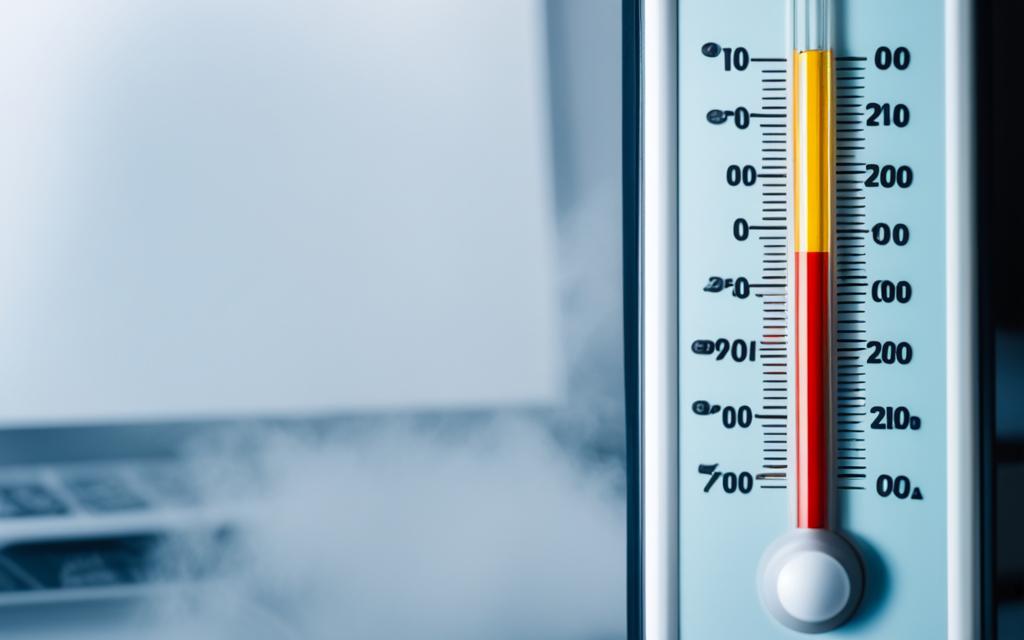Table of Contents
Knowing what counts as a high CPU temperature is key to keeping your computer running well. CPUs need to work in the best conditions, but can suffer if they get too hot. If they stay above 70°C (158°F), they might not last as long as they should, losing up to two years off a ten-year life1.
Once the heat hits 85°C (185°F), your CPU is in real danger. It could get damaged or start working slower than normal2. So, it’s really important to keep an eye on the temperature. This helps your computer work its best.
Key Takeaways
- A CPU temperature above 70°C warrants attention.
- Temperatures exceeding 85°C can lead to critical issues.
- Monitoring CPU temperature is vital for system stability.
- Regular maintenance, including cleaning and thermal paste replacement, is essential.
- Understanding the normal temperature ranges helps prevent hardware damage.
Understanding CPU Temperature Basics
Learning about CPU temperature is crucial for keeping your computer running well. Most CPUs work fine between 40°C and 80°C under usual tasks. They can handle 60°C to 90°C during demanding activities3. When doing heavy tasks like gaming or video editing, the heat may rise to 70°C to 95°C4. It’s important to know about thermal throttling. This means the CPU slows down at 85°C to avoid damage from overheating. This can affect how well your computer works4.
Keeping an eye on CPU temperature helps keep it in the safe zone. You can use tools like HWMonitor, Core Temp, or SpeedFan to check it. To keep the CPU cool, clean dust, refresh thermal paste, and control room temperature3. A cool CPU performs better and lasts longer. It also uses less power. Remember, a CPU can’t be too cold3.
What is High CPU Temp?
Knowing high CPU temp is key for top system work. It can cause hardware failures. Our goal is to identify when temps are too high.
We’ll look into what ‘high’ means and the safe levels for CPUs.
Defining High Temperatures
High CPU temps are outside safe temperature ranges. They range from 70°C to 85°C (158°F to 185°F) for gaming or hard tasks1. At 90°C (194°F), harm chances soar1. Operating above 75°C (167°F) often harms your hardware5.
Safe Temperature Ranges for CPUs
CPUs should stay below 60°C (140°F) for smooth work1. They safely work between 40°C to 65°C (104°F to 149°F) normally. During intense use, like gaming, up to 85°C (185°F) is okay5, but watch for overheating.
It’s crucial to do regular checks. Change thermal paste every three years to avoid temp jumps1.
Signs of Overheating
Understanding the signs of CPU overheating is key to keeping your computer running well. When a CPU overheats, it can cause a lot of issues and even damage. Knowing what to look out for can prevent hardware problems.
Performance Issues
One key sign of CPU overheating is when it starts slowing down. You might see your computer crash or run slower to prevent more heat. The CPU should stay under 80°C when in use and under 60°C when idle6.
When the CPU gets too hot, it struggles to work right. This makes your computer hard to use.
Physical Symptoms of Heat
You can also see physical signs when a CPU gets too hot. Fans might get very loud or run fast all the time. This is because they are trying to cool the CPU down.
If the CPU area feels hot to the touch, that’s bad. It might mean the temperature is over 90°C, which is dangerous78. It’s smart to watch for these signs to stop bigger problems.
Key Causes of High CPU Temperatures
High CPU temperatures can affect both performance and the lifespan of a system. It’s important to know why CPUs get too hot. This knowledge helps keep a system running smoothly. Too much heat can harm the hardware.
Intensive Applications and Multitasking
Games or video editing can make CPU temperatures soar. These activities need a lot of processing power, which creates heat. When you juggle many tasks at once, it gets worse. The CPU works hard to keep up, pushing its limits. If the temperature goes above 80°C, it could cause problems and even damage in the long run9.Keeping an eye on the CPU is key during heavy use to prevent overheating.
Overclocking Effects
Overclocking makes a CPU run faster than its designed speed. This extra load can heat it up too much, especially with demanding tasks. Processors can be OK up to 80°C, but going over 85°C is risky10. At 90°C, the CPU will slow down to cool off, which affects how well your computer works. So, managing overclocking carefully is important.
Poor Ventilation and Dust Build-up
Lack of good airflow can cause CPU overheating. Dust can block air from moving freely, making cooling hard. Make sure your computer is in a place with good air flow. Clean it regularly. A hot room can also make overheating worse. Adjust settings and check cooling systems to keep temperatures down9.
How to Check Your CPU Temperature
Keeping an eye on your CPU temperature is key to top performance and avoiding overheating. Various methods help you check the CPU temperature. You can then fix any problems early on.
Using Software Tools
There are many CPU temperature checking tools that make it easy to watch temps in real-time. Tools like Core Temp, NZXT CAM, and HWMonitor let you monitor your CPU closely. These programs show current temperatures and track high temps over time. This helps you act before hitting critical levels.
CPUs must stay below 80 degrees Celsius when in use. These apps are great for getting timely warnings11.
BIOS/UEFI Method
Another way to track your CPU temperature is through the BIOS. When you start your computer, enter the BIOS or UEFI settings. Here, you can see your system’s temperature. This is a simple way to make sure your CPU stays in a safe range. Ideally, it should be around or below 50 degrees Celsius when not working hard12.
It’s very important to regularly check your CPU temperature. This ensures your system runs well and lasts longer.
FAQ
What is considered a high CPU temperature?
A high CPU temperature is anything over 70°C (158°F). Staying above this temperature can harm performance and shorten the CPU’s life.
How do I monitor my CPU temperature?
You can check your CPU’s temperature using software like Core Temp, NZXT CAM, or HWMonitor. You can also see it in your motherboard settings through the BIOS/UEFI during boot-up.
What are the signs of CPU overheating?
If your CPU is overheating, you might notice your system slowing down or crashing unexpectedly. The CPU may reduce its speed to cool down, known as thermal throttling. Fans may run louder, and the CPU cooler might feel hot.
What causes high CPU temperatures?
High CPU temperatures can come from running demanding apps like games or video editing software. Overclocking the CPU or poor ventilation from dust buildup can also cause overheating. Improper positioning of your computer can contribute too.
What is thermal throttling?
Thermal throttling happens when a CPU gets too hot and slows down to manage the heat. This can affect your computer’s stability and how well it performs.
What is considered a safe operating temperature for CPUs?
Most CPUs are safe between 40°C to 65°C (104°F to 149°F). Even under a lot of stress, going up to 85°C (185°F) is usually okay for a short time.
Source Links
- https://www.pandasecurity.com/en/mediacenter/how-to-check-cpu-temp/ – How to Check Your CPU Temperature – Panda Security
- https://www.avast.com/c-how-to-check-cpu-temperature – How to Check and Monitor Your CPU Temperature
- https://www.linkedin.com/advice/3/what-normal-optimal-ranges-cpu-temperature-different – What are the normal and optimal ranges of CPU temperature for different types of processors?
- https://computercity.com/hardware/processors/normal-cpu-temperatures – Normal CPU Temperatures: Guidelines for Safe & Optimal Performance – ComputerCity
- https://directmacro.com/blog/post/what-is-optimal-cpu-and-gpu-temp – What Is Optimal GPU Temp and CPU Temperature Range
- https://www.linkedin.com/advice/0/what-common-causes-symptoms-cpu-overheating-skills-computer-repair – What are the common causes and symptoms of CPU overheating?
- https://www.drivereasy.com/knowledge/how-to-know-your-cpu-overheating-and-fix-prevent-it/ – How to Know Your CPU Overheating and How to Fix It – Driver Easy
- https://www.avg.com/en/signal/computer-overheating-fix – Why Your PC Is Overheating and How to Fix It
- https://www.reddit.com/r/AnthemTheGame/comments/arc5n0/if_you_have_high_cpu_usage_andor_temps_please/ – Reddit – Dive into anything
- https://www.noyafa.com/blogs/knowledge-base/good-cpu-temperature – What Is A Good CPU Temperature? A Guide to Keep Your Processor Cool
- https://www.tomshardware.com/how-to/how-to-check-cpu-temp-temperature – How to Check Your CPU Temperature
- https://www.avg.com/en/signal/check-cpu-temperature – How to Check and Monitor CPU Temperature on Windows and Mac








